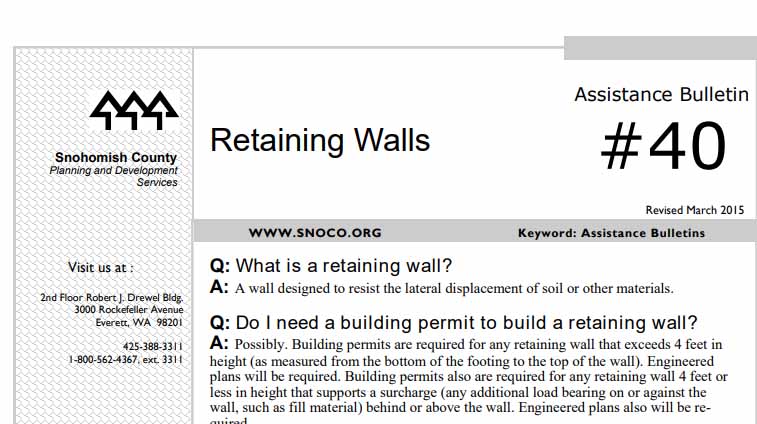Snohomish County in Washington state is characterized by its hilly, mountainous terrain. With elevations ranging from sea level to over 1,500 feet, many properties require retaining walls to create usable flat yard spaces and manage runoff. That’s why retaining walls are incredibly common in the region. However, regulations do exist for the proper design and construction of taller retaining walls to ensure safety and prevent failures. This article will provide an overview of the key retaining wall regulations in Snohomish County that homeowners need to be aware of.
Snohomish County requires permits and engineering for retaining walls over 4 feet high due to the area’s hilly terrain. This article outlines the county’s code requirements including permitted materials, construction standards, safety considerations, and resources for compliant retaining wall design.
Regulations and Permit Requirements
Retaining walls over 4 feet in height are regulated by Snohomish County and require permits for construction. Here are the key permitting and code requirements:
Building Permit – A building permit from the county is required for any retaining wall over 4 feet tall, as measured from the bottom of the footing to the top of the wall. Walls under 4 feet are typically exempt.
Site Plan – The permit application must include a site plan showing the location of the proposed retaining wall on the property and setback distances.
Construction Plans – Detailed construction plans are required showing a cross-section of the wall, elevations, and specifications on materials and drainage.
Engineered Design – An engineering analysis and stamped plans are required for walls over 4 feet high. The engineering must address soil conditions, hydrology, surcharges, and seismic loads.
Setbacks – Retaining walls require setbacks from property lines and structures. Front yard setbacks are generally 10 feet.
Allowed Materials – Common retaining wall materials that meet code requirements include poured concrete, concrete masonry units (CMUs), and large timbers.
Drainage – Proper drainage and backfill must be incorporated per code. Drain pipes, gravel backfill, and weep holes are commonly required.
Landscaping – Any visible portions of the wall above grade require decorative landscaping such as plants or stone facing. Landscaping Companies like ours can help you with any Landscaping Job in Snohomish County.
Engineering Requirements
Retaining walls over 4 feet in Snohomish County require an engineered design with stamped plans submitted for permits. This ensures the walls are properly designed for the specific conditions of each site. Here are some key considerations around the engineering requirements:
The engineering analysis must evaluate soil types, shear strength, and bearing capacity. This impacts the footing and reinforcement needs.
Hydrostatic pressure and drainage need to be modeled based on groundwater, rainfall, and water flows across the site. Proper drainage design is critical.
Any sloped backfill and loads from adjacent structures must be included in the structural analysis. This can significantly increase pressures.
Seismic analysis is important given the earthquake risk in Washington. The design must account for dynamic earth pressures.
Hire a licensed civil or structural engineer experienced in geotechnical engineering. They should be able to provide stamped plans and calculations tailored to the site.
The engineer should outline the recommended materials, orientations, reinforcement, drainage, and factors of safety in the plans.
Work closely with the engineer during the build to ensure construction follows the approved plans.*Snohomish County Retaining Walls Code #40

Materials and Construction
Snohomish County outlines specific materials and construction methods that are permitted for code-compliant retaining walls:
Poured Concrete – Fully poured concrete retaining walls are common. Concrete mix, reinforcing bar spacing, and footing specifications must follow code requirements.
Concrete Masonry Units – CMU block walls are also very common. Grout-filled cells, steel reinforcement, bond beams, and surface textures/colors are important considerations.
Large Timbers – Walls using timbers or railroad ties must use large, thick members with proper connections and preservation treatment.
Proper Drainage – Drain pipes, gravel backfill, and weep holes are required for proper drainage and water management behind the wall.
Decorative Veneer – The exposed wall must have a textured, colored, or stone-veneer surface facing for an attractive finish.
Inspections – Getting the right inspections during construction is critical to meet code. They will verify proper materials, drainage, reinforcement, and design per the approved plans.
Safety Considerations
Retaining walls can fail due to poor design, drainage, or maintenance. It’s critical that taller walls follow the regulated design and construction practices. Here are some key factors in retaining wall safety:
Overturning – Adequate footing size and soil bearing capacity help prevent overturning.
Sliding – Stable slopes, base friction, and shear strength prevent sliding.
Bulging – Proper drainage and backfill prevent buildup of lateral pressure.
Reinforcement – Geogrids and tiebacks help reinforce taller walls against pressure.
Terracing – Retaining walls above 8 feet often require terracing to reduce pressures.
Maintenance – Periodic inspections of drainage and soil settlement are needed.
Properly following the published retaining wall regulations results in walls engineered for long-term stability and safety on sloped properties. Homeowners should consult the county building department early in the process when planning any wall over 4 feet high. Need help with your Retaining Wall Project in Snohomish?
Conclusion
Retaining walls are very common in hilly Snohomish County for creating usable spaces on sloped properties. Homeowners planning walls over 4 feet high must be aware of county regulations that require permits, engineered designs, proper materials and drainage, and inspections. Following the published codes results in walls that are designed to withstand the specific conditions of a site. Key takeaways include:
Obtain permits and engineering for walls over 4 feet high
Work with qualified engineers and contractors Follow approved plans during construction
Use reinforced materials and proper drainage
Get required inspections during building
Conduct regular maintenance for safety
For more information on retaining wall permits and resources in Snohomish County, visit the county’s website at snohomishcountywa.gov/ or contact the building department.
Looking for a reliable Landscaping Company? We do work in Skagit, King, and Snohomish County.
FAQ:
Q: What size retaining wall requires a permit in Snohomish County?
A: Retaining walls over 4 feet in height require a building permit from Snohomish County. Walls under 4 feet are typically exempt from permits.
Q: What must be submitted for a retaining wall permit application?
A: The permit application must include a site plan, construction drawings, and an engineering analysis with stamped plans for walls over 4 feet high.
Q: Who can design and stamp plans for permitted retaining walls?
A: A licensed civil or structural engineer experienced in geotechnical engineering must design and stamp the engineering plans for permitted retaining walls.
Q: What materials can be used for retaining walls in Snohomish County?
A: Approved materials include poured concrete, concrete masonry units (CMUs), large treated timbers, and other materials meeting code requirements.

